Magic of neuroscience -How accurate is our brain?
Afterimage -neural adaptation
This article was adapted from http://sciwrite.org/sciwrite/sleights%20of%20mind%20proposal.pdf accessed Monday 5/12/2011
The Woman With the Chameleon Dress
Brain mechanisms, such as neural adaptation, make us "miss" important changes throughout life. Neural adaptation is when our neural system responds to a constant stimulus over time by a decrease in firing rate. It is as if neurons actively ignore a constant stimulus to save their strength for signaling that a stimulus is changing. When the constant stimulus is turned off, the adapted neurons fire a "rebound" response known as an afterdischarge. Magicians use neural adaptation in tricks such as the Chameleon Dress performed by the magician known as The Great Tomsoni.
The spotlight shines on the magician's assistant. The woman is wearing a tiny white dress. The Great Tomsoni announces he will change her dress from white to red. Intrigued, the spectators strain to focus on the woman, burning her image deep into their retinas. Tomsoni claps his hands, and the spotlight dims ever so briefly before reflaring in a blaze of red.
The woman is awash in a flood of redness. Wait a minute! Switching color with an ordinary spotlight is not exactly what the audience has in mind. The magician stands at the side of the stage, looking pleased at his little joke. Yes, he admits, it was a cheap trick; his favorite kind, he explains devilishly. But you have to agree, he did turn her dress red—along with the rest of her. Please, indulge him and direct your attention
once more to his beautiful assistant as he switches the lights back on for the next trick.
Tomsoni claps his hands. The lights dim again. Then the stage explodes in a supernova of whiteness. But wait! Her dress really has turned red. Bright crimson red. The Great Tomsoni has done it again.
This trick reveals a deep intuitive understanding of neural processes taking place in your brain.
Here's how the trick works.
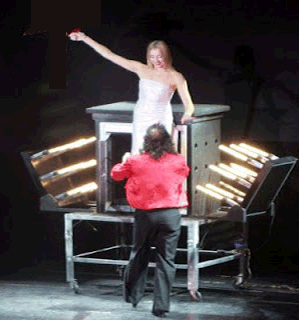
All during Tomsoni's banter after his little "joke," each spectator's visual system is undergoing a brain process called neural adaptation. In this case, the adapting stimulus is the red-lit dress, and Tomsoni knows that the spectators' retinal neurons will rebound for a fraction of a second after the lights are dimmed. The audience will continue to see a red afterimage in the shape of the woman. During that split second, a trap door in the stage opens briefly, and the white dress, held only lightly in place with Velcro and attached to invisible cables leading under the stage, is ripped from her body. Then the lights come back up.
Illusion of colour can be created when neurons become desensitised, this is called neural adaptation. Neural adaptation can occur in other senses such as touch, smell hearing. You may have lost your sunglasses and spent time looking for them only to find them resting on the top of your head. Touch receptors may have given you a definite and strong indication that your glasses were on top of your head when you first put them there, but overtime, the signals from the touch receptors faded to the point that you were oblivious to the fact that they were resting on top of your head.
Neural adaptation saves energy by reducing the metabolism of neurons that do not receive new information. However, staring at a stationary object can cause you to become blind to the scene as neural adaptation takes hold. Human eye actually undergo small movements, called microsaccades, that shift the entire visual scene across the retina, prodding visual neurons into action and preventing stationary objects from fading away. Microsaccades are responsible for some of the illusions of motion generated when you fix your gaze at a picture, as shown on the right.
Click to see another illusion. In this illusion you will notice, as you stare, black spots racing around the circular tracks.
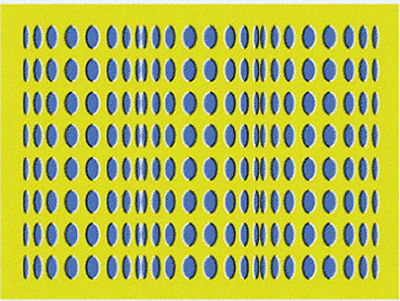
Neural adaptation is behind the afterimage that we so often experience when we look away from an object that we have been looking at for a while.The afterimage always shows the colour that is complementary to the colour of the image. Complementary colours are those that are exact opposites in the way the brain perceives them. Eyes simply pick up green, red and blue wavelengths, it is up to the brain to create the array of colours that we see in our environment.
It is a common misconception that red is complementary to green. Similarly, orange is complementary to blue, and yellow to violet as shown in the illusion on the right below.
Click to see the influence of the afterimage affect on the illusion of colour on the black and white pictures on the right. Look at the dot in the middle of the colour picture.
Click to see another illusion

Click to view the video on the right. Concentrate on the word "Jesus" in the centre.
What do you observe? Explain how this is possible. Use the terms, neural adaptation, complementary colour.

Second, Tomsoni performs the real trick only after the audience thinks it is already over. That gains him an important cognitive advantage—the spectators are not looking for a trick at the critical moment, and so they slightly relax their scrutiny.
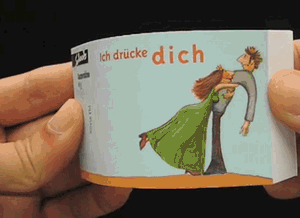
The motion aftereffect is a visual illusion experienced after viewing a moving stimulus for a time with stationary eyes, and then fixating on a stationary stimulus. The stationary stimulus appears to move in the opposite direction to the original stimulus.
This is also an example of neural adaptation. Neurons coding a particular movement reduce their responses over time of exposure to a constantly moving stimulus. When viewing a stationary object the object appears to move in the opposite direction to the moving object that caused neural adaptation. Neurons exist that respond to movement in a certain direction. Their activity is balanced by neurons that respond to movement in the opposite direction.
For example, when looking at a waterfall for a certain length of time and then viewing the rocks on the side of the waterfall, the rocks appear to be moving slightly upwards. This comes about due to neurons, stimulated by downwards movement, reducing their activity, tilting the balance in favor of upwards movement.
Click to view the video on the right. Stay fixated on the blue circle, even when the image changes.

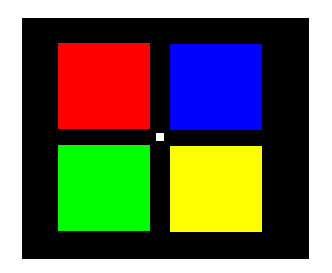
Try these experiments.
Focus on the small white square in the middle of the picture for about 15 seconds Try not to blink. Then move your mouse so that the cursor moves into the picture. This will cause the picture to turn white. Look at the white picture. You should see colors.
What colors do you see?
What are the complementary colors of red, blue, green and yellow?
Here is one more experiment to try. Close your right eye. With your left eye, focus on the small white square in the middle of the picture for about 15 seconds. Try not to blink. Then move your mouse so that the cursor moves into the picture. This will cause the picture to turn white. Look at the white picture with your left eye, then open your right eye and look. Switch back and forth, opening and closing each eye. With which eye do you see the afterimage?
What does this tell you about where the afterimage is created?
Is it created by the eye or is it due to brain interpretations?
Click to reveal a moving square. Try the experiment again, except this time move your eyes to follow the little circle. After following the square for 15 seconds, change the picture to white by moving your cursor. Do you still see the colors? Explain
What's Happening: in the retina of your eyes, there are 3 types of color receptors (cones) that are most sensitive to either red, blue or green. When you stare at a particular color for too long, these receptors get "tired" or "fatigued." This is called neural adaptation. When you then look at the white background, the receptors that are tired do not work as well. Therefore, the information from all of the different color receptors is not in balance and you see the color "afterimages."
In the experiment when you follow the moving square, your eyes are always moving. Therefore, you do not give a particular neurone the chance to tire.
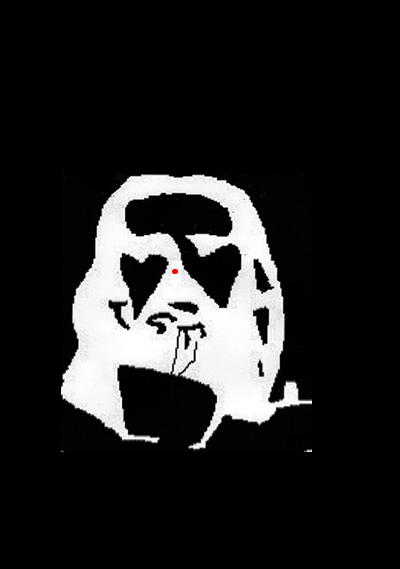
Many people claim to have had seen visions of certain famous people or religous figures.
Consider the image on the left. Look closely at the red dot in the middle. After 30 seconds Click to remove the picture.
See another image
Click to see the afterimage.
Why do you think you see the afterimage colors that you do?
White is formed by a mixture of green, blue and red lights. Knowing that there are three types of cone cells in the retina that pick up red, blue and green light and that secondary colors such as yellow, purple/magenta and cyan are mixtures of red, blue and green, explain how the coloured afterimage of the square on the right is formed.
Explain how a nerve cell conveys information along a network and how it can become fatigued. Words to use are neurotransmitter and synapse. A drawing of a nerve cell is also required.
This link may be of assistance
Investigation. Set up a scientific inestigation to answer one or both of the questions below.
How long does it take for cones in the retina to fatigue and to recover fully?
Does the recovery time differ in different people?
